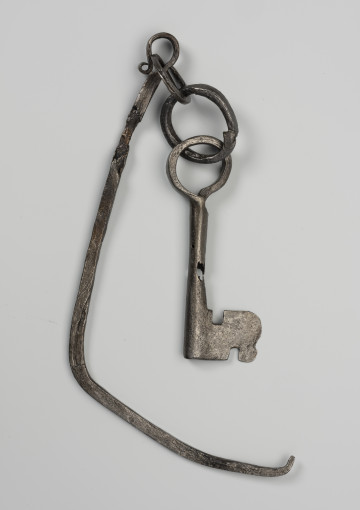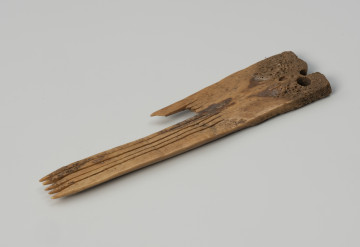
Bucket stave
901 — 1200
National Museum in Szczecin
Part of the collection: Middle Ages
Amber goods are unique and rare finds. It is believed that amber objects were also precious, even luxurious, in the Middle Ages. Among those is an X-shaped pendant from excavations in Szczecin Podzamcze. The amber raw material was found all along the Baltic coast in present-day Poland. Initially, amber products came from domestic production for personal use. It was only later that a craft began to develop, probably related to antler craftsmanship. The simplest way of working amber was by hand using a knife, chisel, saw and auger. First, the lump of amber had the top layer, the so-called cortex, cleaned off. Often at this point the hole was also drilled, as this was a very difficult procedure and cracking of the material could occur during drilling, as evidenced by the scrap found. The hole was drilled from one side outwards or from two sides, while the latter method was sometimes unsuccessful as the holes did not meet in one axis. Only when the hole was ready was the redundant material removed with a knife and a coarse file and given a definite form. Finally, the product was submitted to grinding and polishing to smooth out irregularities and shine the surface. Beads with a rounded shape were also worked on a lathe. The roughly rounded blank was turned with a piece of glass, an iron blade called “rzeziwo,” and possibly flint. The object was then ground and polished to give it a final design. Ewa Górkiewicz-Bucka
Author / creator
Object type
pendant, pendicle
Technique
drilling, cutting, polishing, grinding
Material
amber
Origin / acquisition method
legal transfer
Creation time / dating
Creation / finding place
Owner
Muzeum Narodowe w Szczecinie
Identification number
Location / status

901 — 1200
National Museum in Szczecin

1176 — 1200
National Museum in Szczecin

1176 — 1200
National Museum in Szczecin
DISCOVER this TOPIC
Castle Museum in Łańcut
DISCOVER this PATH
Educational path